Decentralized Applications (DApps) - Crypto Academy S5 - Homework Post for Task 8
What are dApps? Explain the working system of dApps? What are the differences between dApps and other applications? Explain the advantages and disadvantages of dApps? How can dApps developers promote their apps? What should we pay attention to when using dApps? How do we find the information of a DApp that we want to know? Provide the steps (Screenshot required).
What are dApps (Decentralized Apps)?
.jpeg)
Digital programs or apps known as decentralized applications (dApps) run on a blockchain or peer-to-peer (P2P) network of computers rather than on a single computer. DApps (sometimes spelt "dapps") are decentralized applications that exist outside of the control and jurisdiction of a single authority. DApps, typically built on the Ethereum platform, can be used for a variety of purposes like as gaming, finance, and social networking.
A conventional web app, similar as Uber or Twitter, runs on a computer system that's possessed and maintained by a company, allowing them complete control over the program's functionality. On one side, there may be several druggies, but the backend is managed by a single company.
DApps can run on a peer-to- peer or a blockchain network. BitTorrent, Tor, and Popcorn Time, for illustration, are software that run on computers that are part of a peer-to- peer (P2P) network, in which multitudinous actors are consuming, feeding, or sowing content, or doing both places at the same time.
In the context of cryptocurrencies, decentralized applications (dApps) run on a blockchain network in a public, open-source, decentralized environment, free of any single authority's control and intervention. A developer may, for example, design a Twitter-like dApp and deploy it on a blockchain, allowing any user to submit messages. No one, including the app's founders, has the ability to erase messages once they have been posted.
DApps, or decentralized operations, are blockchain- grounded smart contract-powered performances of the Ethereum network's vulgarized apps. They bear also to standard apps — the stoner should be unfit to tell the difference — but offer significantly further functionality.
DApps are a new way to connect with your particular finances. Traditional finance conjures up images of plutocrat lending, borrowing, and savings, among other effects. Each bone is fueled by a central authority, similar as banks or other fiscal institutions.
Three types of decentralised apps have been developed as a result of the progress that blockchain technology has made thus far:
Type I: decentralized applications with their own blockchain. Bitcoin is a best example of this.
Type II: dApps are those that make use of the type I dApp's blockchain. All Ethereum-based dApps, for example, are type II dApps. Type II dApps are essentially protocols that must issue tokens in order to operate. The Omni protocol is one such example.
Type III: dApps are those that use the same protocol as type II dApps. Tokens are required for them to work. The SAFE network, for example, is a type III dApp that uses the Omni protocol to issue'safecoins.
Working System of dApps
Dapps use a decentralized network to operate their backend code (smart contracts), rather than a centralized server. For data storage, they employ the Ethereum blockchain, and for app logic, they use smart contracts.
A smart contract is similar to a set of rules that reside on-chain for anyone to observe and follow exactly. Consider a vending machine: if you give it enough money and the appropriate selection, it will give you what you desire. Smart contracts, like vending machines, can store funds in the same way that your Ethereum account can. As a result, code can be used to mediate agreements and transactions.
You can't make changes to dapps once they've been published on the Ethereum network. Because the logic built into the contract, rather than a human or a firm, controls Dapps, they can be decentralized.
These programs are hosted on a centralized hosting service. In the event of a malicious attack, acquiring control of the central system would be enough to bring the entire program down.
The front-end and back-end aspects of dApps are identical, with the exception that the back end is built on a blockchain and data is dispersed over numerous hosting nodes. After all of the hosting nodes have achieved an agreement, data is fed into the system (i.e. an agreement).
Differences between dApps and other Applications
Every business person uses an application to reach out to additional users and consumers, even through mobile phones, in order to expand their business.
However, a Dapp, or decentralized application, is one that uses the decentralization principle. i.e., there will never be a single point of control in a dapp, and authority will be diffused to everyone.To link people with an app, an intermediary is required.
However, a dapp does not need an intermediary and automatically communicates with users.Developers or owners can only make changes to the codes and functions of an app while it is under their control.
However, a dapp automatically modifies codes and functions, avoiding the need for developers to intervene.Apps are run on a server. Sometimes. Some are from the area.
Dapps, on the other hand, use a decentralized peer-to-peer network for their backend code. It's becoming more private. Oracle's staff commonly collaborate using dapps.
Advantages and Disadvantages Explanation of dApps
Advantages
The key advantage is that it is resistant to censorship. It is extremely impossible for any individual or government to manage or restrict access to the Dapp because it is not controlled by a single body.
It is based on a peer-to-peer network of computers and does not rely on a single point of failure, like a hosting server does. There will be no downtime or limitations as a result of this.
Dapps are free and open source. This promotes the ecosystem's development at a faster and more secure rate.
Because they generally keep sensitive data on a blockchain, dApps are erected to repel any attempt to modify that data in order to steal plutocrat or bowdlerize content. Because each item is included into the hashed value of the succeeding entry, this is possible because a blockchain maintains information in a fashion that can not be modified unless all of the hosts agree that the change is valid.
Many dApps use cryptocurrencies; Bitcoins launched blockchains, the technology that dApps rely on, and cryptocurrency transactions remain the most common use of the technology. By compensating content providers and incentivizing specific users to host a "full node" - a duplicate of the dApp's whole blockchain that accepts incoming transactions and possibly verifies them through "mining," cryptocurrencies can help to boost activity on the platform.
Many dApps that use cryptocurrencies develop their own internal token; these are frequently built on Ethereum and connected with its blockchain, because Ethereum's ERC-20 standard makes it very easy to establish a token.While the inherent freedom from outside intervention has made dApps increasingly popular among many of the same libertarians who first championed cryptocurrencies, they have also been used to create applications that do not require privacy or security, such as games and networks for sharing entertainment content. It will be exciting to watch how the technology develops as more software developers get interested in dApps.
Most traditional applications rely on their developers or some other central authority to enable transactions and make platform-level decisions, but dApps are completely self-contained once launched.
This means they are unaffected by other influences, such as developers, corporations, or governments. Because each user has a stake in the data and platform's management, penetrating it would necessitate manipulating a majority of them.
Disadvantages
They're more prone to hacking. Due to the fact that many of them are based on open-source smart contracts, hackers can seek for flaws to attack. A wallet is a great way to keep track of your money.
Usability is still a problem that has to be addressed. Because the ecosystem is complicated and there are a lot of new ideas to learn, many Dapps are still difficult to find.
There aren't enough people. Many Dapps suffer from low user numbers as a result of their early status, making them less usable and lacking in content. However, for early adopters, this promises a slew of new possibilities.
Fixing any faults with DApps is challenging since it requires each peer in the network to update all of the copies in the network, which can be a laborious operation.
The majority of today's centralized apps rely on user authentication, which is quite simple because it is controlled and verified by a single authority. However, because DApps lack a single organization accountable for KYC verification, it is difficult to create DApps.
In order to reach data validation consensus, DApps must use complicated networks and protocols. To do this, the entire DApp must be developed and built from the ground up with scale in mind. This isn't the case with centralized programs, where you can design an MVP first and then balance the system based on requirements later.
We often have to rely on third-party APIs to collect certain third-party information under the present centralized app method. We don't have similar advantage with DApps because there is presently no such massive third-party DApps ecosystem in existence.
Ways Developers can Promote their Apps
Website: For your app to be successful, it must have an online presence. Why? Legitimacy. People want to know that your app is legit and that you've put your heart and soul into it.
Your app should not be an afterthought or a modest branding in the bottom for enterprise brands. Rather, it should be present throughout, whenever it is appropriate.The Internet and Social Media: App promotion requires the use of social media. You may interact with your audience on social media in two ways; the paid and organic.
Organic social media promotion is as basic as having a presence; for example, a Facebook page, as well as Twitter and Instagram profiles. Create profiles and begin following people in your desired demographic and industry. Instead of being overtly promotional, attempt to connect with your audience in a meaningful way by writing about topics that they care about and participating in discussions.
According to a 2016 Kenshoo analysis, mobile app ad click-through rates (CTRs) increased by 32% year over year, while CPC (cost per click) fell by 33%. Investing in app promotion will increase your app's discoverability and increase the number of people who download it. Facebook and Instagram are particularly successful advertising channels for mobile apps because of their large audiences and ability to segment. Because Facebook owns Instagram, placing app install advertising on both platforms is relatively simple.Public Relations: They say there's no such thing as negative press unless it's none at all. Mentions in the media and by influencers go a long way toward building buzz and credibility. There are numerous approaches to take, but here are a few to consider; i) a news release, ii) Invite local media and tech influencers to a launch party, iii) Interviews with local journalists and bloggers on the topic of technology, iv) Blogging by a guest.
Buzzworthy/word-of-mouth: Make certain your app isn't a flop. Seriously. The power of word-of-mouth is still undeniable. As a result, if you create an app, it must be good. When it comes to world-class apps, the competition is tough, and app users are spoiled for choice. That's why, before you spend money on acquiring app users, you should invest in a mobile marketing platform, or mobile app marketing software, that provides you with the data you need to engage and keep your customers while also predicting churn risk.
What Should be Paid Attention to when using dApps
Cryptocurrency has a lot of great potential, but it also has a lot of risk, which most people are unaware of before investing. There are a slew of fraudulent Dapps out there with appealing terms and conditions. They're known as high-risk Dapps.
The vast majority of high-risk Dapps claim to be transparent, decentralized, and compatible with well-known exchanges, but they aren't. They also claim to give tokens to users who join through your link.
Before investing in any of these dApp projects, do your homework.
How to find Information of a dApp we want to know
Step one: First thing to do is to access the site using the link provided below.
Link
Step two: When you've able to access the site, then you click on a box like icon by the topmost left to access the list there.
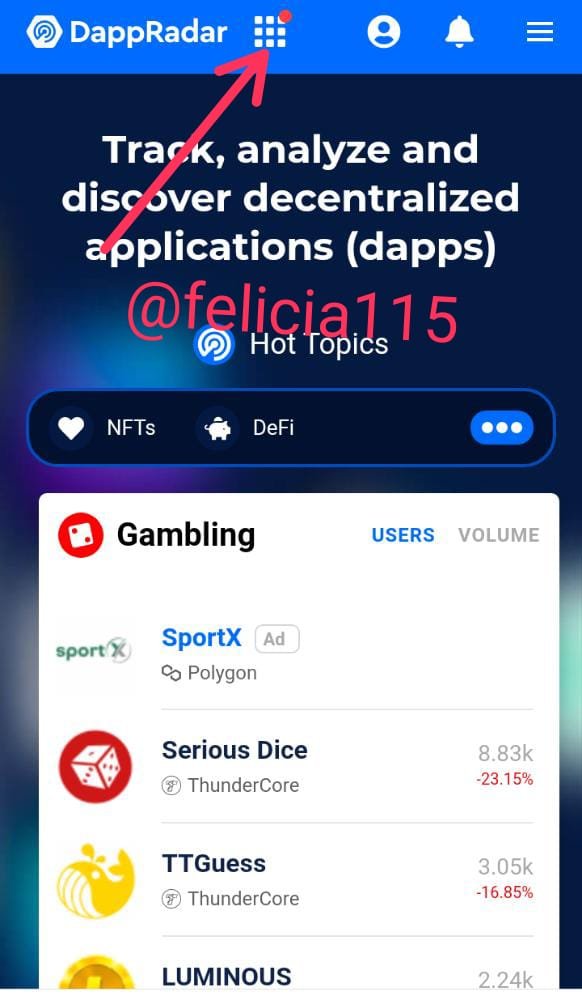
Step three: When the list shows, the next thing to do is to click on ranking where you can access series of dApps.
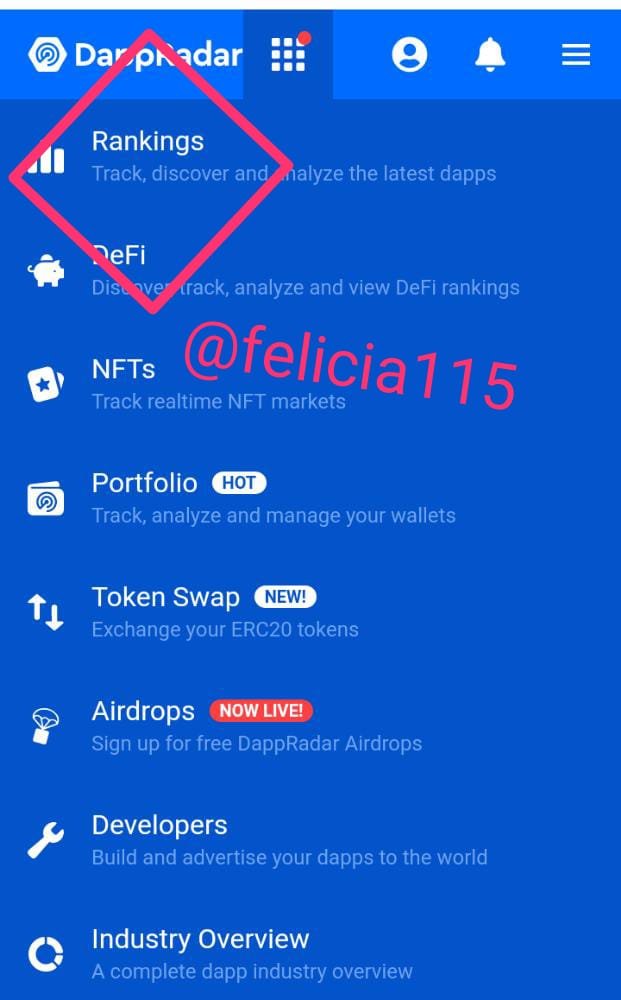
Step four: List of dApps will show then I decided to choose on of the topmost app which is the pancakeswap App
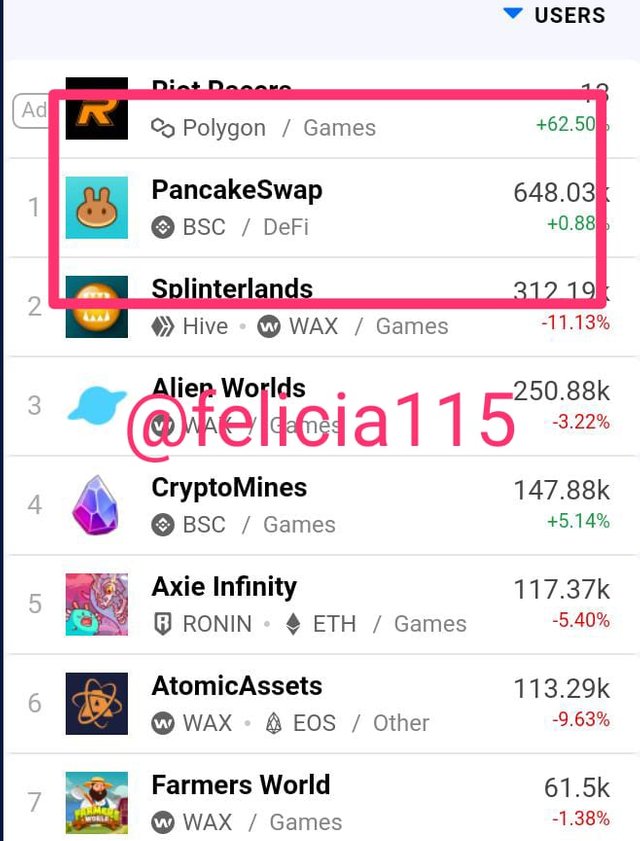
Step five: Next thing is to click on the app, a page showed and there was an option for open to access the app
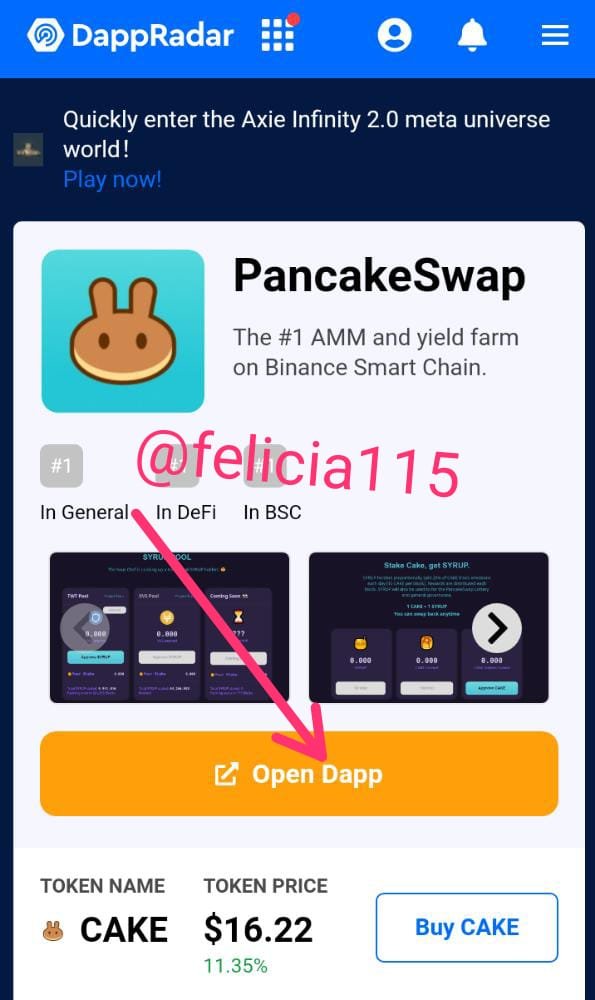
Step six:
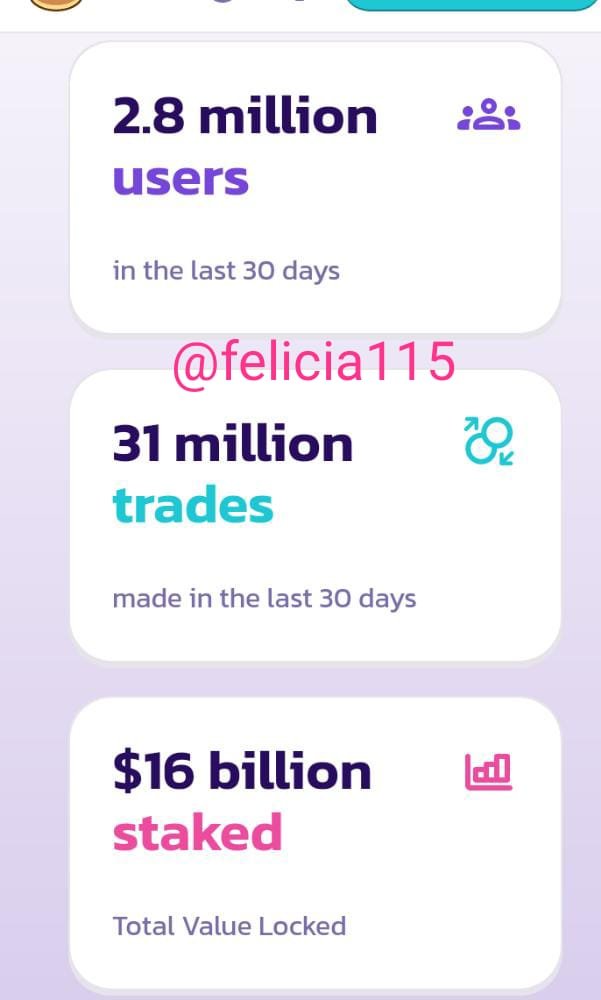
The above shows the number of users, trades, and stake market of Pancakeswap as of present.
Thank you for giving this opportunity to learn more about decentralized apps and I must say it has been helpful.
I humbly await your reply and correction in order to help me further.
.jpeg)